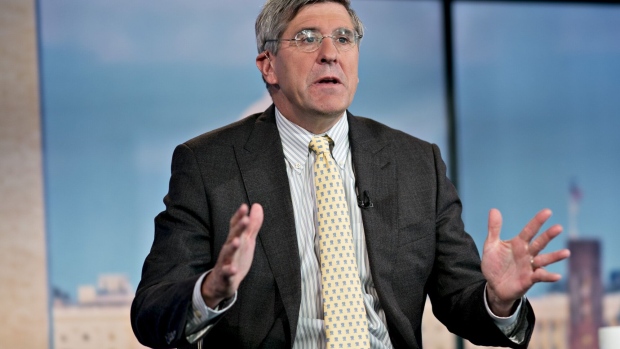Apr 17, 2024
Trump Pushed to Embrace 17% Income Tax for All
, Bloomberg News

(Bloomberg) -- Donald Trump is under pressure from economists in his circle to embrace a flat tax rate, soften his trade stance and to hold the line on the state and local tax deduction.
The minds behind these proposals include Steve Forbes, of Forbes Media, former White House economic adviser Larry Kudlow and economists Stephen Moore and Arthur Laffer. The men, who aren’t official advisers to his campaign, typically emphasize unleashing the supply potential of the economy with lower taxes, and to a degree that would have been unremarkable in the 1980s but which places them outside the economics mainstream today.
The efforts demonstrate how people around the former president are already lobbying for their preferred economic policies ahead of a potential second term where both taxes and tariffs will be top priorities. Polls show voters trust Trump to handle the economy by a much higher margin than President Joe Biden.
Forbes said Monday at a New York City event that he is advocating for Trump to support a flat 17% tax rate for all income brackets with “generous” exemptions — an idea he’s pushed for decades including when he ran for president in the late 1990s. For a family of four, he said, he would suggest the first $54,000 of income be exempt from federal income tax.
Moore said that Trump hasn’t yet said he supports a flat tax, which would appear to benefit the rich. Under the current system, tax rates increase as income levels rise, meaning higher-earners are supposed to pay a larger share of their income in taxes compared to those who make less.
Whoever wins the White House in November will be forced to negotiate a tax deal next year because key portions of Trump’s 2017 tax cuts — including individual rates — expire at the end of 2025. That will set up a complex negotiation — particularly if control of Washington is split between Republicans and Democrats — that could make dozens of changes to the Internal Revenue Service code.
Corporate Cuts
Kudlow has praised Trump’s 2017 tax cut, which lowered the corporate tax rate to 21% from 35%, as an “enormous success.” Laffer said he supports lowering the corporate rate even further, though his ideal goal is to replace the corporate income tax with a value-added tax.
Trump has told allies he wants to keep the 21% rate in place, instead of cutting it further to 15% as he previously proposed, seeking to avoid alienating working-class voters.
Read More: Trump Eyes Keeping 21% Corporate Tax, Extending Individual Cuts
Monday’s event was organized by the Committee to Unleash Prosperity, a group that counts Forbes, Laffer, Kudlow and Moore among its founders and organizers, and is one of the entities regularly bringing policy ideas to Trump. They say they meet with the former president approximately every six weeks to brief him on policy ideas, share economic data and suggest names for key political appointee posts.
Laffer last month floated himself in a list of names to serve as Federal Reserve chair. In an interview Wednesday, he said he would rather serve as a White House adviser than Fed chair.
On the campaign trail, Trump has often said he would pass the “biggest” tax cuts and claims that if he is not elected, taxpayers will see their IRS bills increase under Biden. Trump has not detailed what his tax plan would look like.
“President Trump proudly passed the largest tax CUTS in history,” Trump campaign spokeswoman Karoline Leavitt said in a statement. “When President Trump is back in the White House, he will advocate for more tax cuts for all Americans and reinvigorate America’s energy industry to bring down inflation, lower the cost of living, and pay down our debt.”
Trump’s 2017 tax cut was the largest cut in terms of real dollars, but not as a percentage of gross domestic product.
Forbes advocated for no taxes on savings and eliminating the estate tax, both changes that would disproportionately benefit the wealthiest Americans. Laffer said he has spoken with Trump about a payroll tax cut, which was an idea the former president repeatedly floated during his time in the White House.
State and Local Tax
The advisers are also advocating to maintain or reduce the $10,000 cap on state and local tax, or SALT, deductions. Trump’s 2017 law imposed the $10,000 SALT write-off limit, which was previously unlimited.
That change was most acutely felt in high-tax states, including New York and New Jersey. Democrats are more inclined than Republicans to advocate for expanding the deduction, but a handful of key House GOP lawmakers representing the New York City suburbs and Southern California — districts that will likely determine who controls the House next year — also support expanding the tax break.
Moore said he also doesn’t see eye-to-eye with Trump on trade policy. As president, Trump instigated a bevy of new tariffs, on washing machines, solar panels, steel, aluminum, and other goods from China, which economists say have raised prices for consumers and started tariff wars with trading partners.
“I disagree with Trump, and he knows it, on some of the tariff policies,” said Moore, who called himself a “free trade guy.”
Moore said he’s learned to live with Trump’s desire for trade reciprocity and tit-for-tat tariffs.
“The whole idea of this group is to provide President Trump and other top policymakers with the economic advice they need,” he said. “He doesn’t always take our advice but he likes our thoughts.”
(Updates with additional context on Trump 2017 tax cut, payroll tax)
©2024 Bloomberg L.P.







